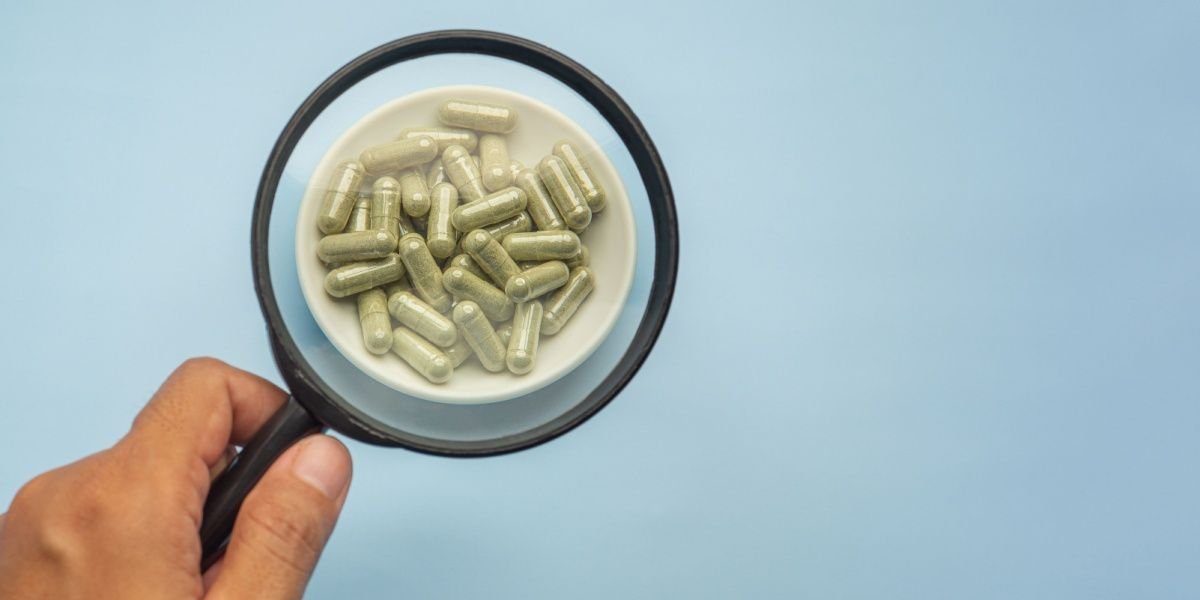7-hydroxymitragynine is kratom’s most powerful alkaloid. You may have heard about kratom as a plant-based supplement that some people use to ease pain or help taper off opioids. Kratom contains a range of chemical compounds; 7-hydroxymitragynine stands out for its strong effects on the body’s opioid receptors. [1] That strength draws attention from people hoping to find an alternative pain remedy, but it can also place them at risk for dependence, withdrawal, or an unexpected health crisis.
If you’re reading this because you’ve been curious about 7-hydroxymitragynine or you’ve tried it for yourself, you’re not alone. More and more people see it advertised in smoke shops, find it online, or learn about it in social media conversations on chronic pain relief. However, stories about hospital visits, lawsuits, and regulatory clampdowns are becoming increasingly common. [2]
The reality can feel confusing: Is 7-hydroxymitragynine a hidden gem for pain or a potential “monster drug,” as a recent news report labeled it? [3] Below, we’ll unpack the facts, share some perspectives from people who’ve used it, and suggest healthier ways to navigate chronic pain or substance dependence.

What is 7-Hydroxymitragynine?
Kratom (Mitragyna speciosa) grows naturally in Southeast Asia, and people in that region have used kratom leaves for centuries to manage fatigue or mild pain. In recent years, kratom products have spread worldwide. These products contain an assortment of alkaloids, but two in particular—mitragynine and 7-hydroxymitragynine, get the most attention. Mitragynine is more abundant, yet 7-hydroxymitragynine tends to be significantly more potent in binding to mu-opioid receptors in the brain, the same receptors involved in traditional opioids such as oxycodone or morphine. [4]
Most raw kratom leaves contain relatively low levels of 7-hydroxymitragynine. The body also breaks down kratom to 7-hydroxymitragynine. The problem is that some modern manufacturing methods concentrate or “enhance” the amount of this alkaloid. People then wind up with capsules, powders, or liquid extracts that can deliver higher doses more quickly. A consumer might purchase a product labeled “extra strength” without realizing just how intense the effects could be.
When 7-hydroxymitragynine binds to opioid receptors, it can alter pain perception and produce a sense of calm or euphoria. That may sound appealing if you’re dealing with chronic pain or trying to step down from harsher opioids. But like any substance with opioid-like effects, there’s a risk of sedation, respiratory depression, and habit formation. Even if you only mean to use it on occasion, your body can adapt, making it difficult to stop once you rely on it to feel “normal.”
Why people turn to it
Many people turn to 7-hydroxymitragynine for deeply personal reasons—often seeking relief, autonomy, or a safer alternative to conventional treatments.
Chronic pain relief
One of the biggest draws to kratom, and by extension, 7-hydroxymitragynine, is the quest for a gentler approach to pain. Maybe standard painkillers left you tired, moody, or dealing with side effects you couldn’t tolerate. It’s natural to look for a different solution, especially one marketed as plant-based. Some folks do report genuinely better pain control and fewer side effects than they experienced on prescription opioids. They talk about increased mobility, fewer flare-ups of discomfort, and an overall improvement in daily life activities.
Opioid withdrawal
Others first encounter 7-hydroxymitragynine while searching for a way to reduce cravings or cope with withdrawal symptoms from heroin or prescription painkillers. Because this compound attaches to the same receptors (though not always with the same full agonist effect), it can take the edge off tremors, sweats, agitation, or body aches that often accompany opioid withdrawal. [4] Some people find the relief they experience life-changing, allowing them to function without the relentless pull of more potent opioids.
Avoidance of medical systems
A third factor is the desire to avoid stigma or complicated doctor visits. Some people, burned by negative experiences or frustrated by limited access to specialized pain clinics, see kratom as a way to manage their problems associated with pain or emotional distress outside the traditional healthcare system. This path can appear attractive if cost or judgment from medical professionals stands in the way of seeking conventional treatments.
All these reasons, however, need to be balanced with a clear understanding that 7-hydroxymitragynine is not risk-free. Its reported potency can be a double-edged sword: enough to tackle discomfort but also strong enough to prompt physical and psychological dependence.
The hidden risks
While 7-hydroxymitragynine may offer benefits, it also carries serious risks that are often overlooked or misunderstood.
Dependence and withdrawal
When we hear “opioid receptors,” many of us think about the addiction epidemic that affects countless people and their families. Though 7-hydroxymitragynine might not have the exact same impact as prescription opioids, it still creates a similar feedback loop in the brain. Over time, your body may require continuous dosing to avoid withdrawal symptoms—things like restlessness, irritability, muscle aches, or sleep disturbance. [4] For people already juggling addiction issues, this can become a slippery slope.
Overdose-like effects
A news outlet’s report on what they called the “7OH monster drug” highlighted concerns about extremely high potency, especially when combined with other downers such as alcohol or benzodiazepines. [3] Because 7-hydroxymitragynine can cause sedation, using it in tandem with other sedatives increases the risk for life-threatening respiratory depression. Some emergency room visits involve patients who are deeply unconscious or struggling to breathe, and toxicology tests uncover kratom along with additional substances.
Quality and labeling
Kratom products, including extracts heavy in 7-hydroxymitragynine, are sold by a range of vendors, many of whom don’t adhere to standard quality control practices. Labels might brag about potency without clarifying how much of the alkaloid is really inside. Batch-to-batch inconsistency means a usual dose could suddenly be far more powerful or contain contaminants like heavy metals or harmful bacteria.
Legal liabilities
When people experience severe harm, lawsuits often follow. There have been cases where families allege that unregulated kratom products led to hospitalizations or fatalities, partly due to undisclosed high 7-hydroxymitragynine content. [2] Courts are left to sort out whether kratom companies gave inadequate warnings, misled consumers, or produced dangerously potent mixes. Regardless of any single court outcome, these cases shine a light on the vacuum of consumer protections in the kratom marketplace.
Recognizing signs of concern
If you’re worried about your use or a loved one’s relationship with 7-hydroxymitragynine, a few warning signals can include:
- Increasing tolerance: Needing more product to achieve the same pain relief or “lift.”
- Persistent cravings: Feeling anxious or preoccupied if you can’t take a dose at the usual time.
- Withdrawal symptoms: Exhibiting flu-like aches, agitation, insomnia, or GI distress if you skip a day.
- Polysubstance use: Relying on alcohol, benzos, or other opioids alongside kratom extracts.
- Lifestyle disruptions: Missing work, ignoring relationships, or losing interest in activities due to sedation or the urge to dose repeatedly.
Finding support and safer alternatives
- Medical evaluation: If chronic pain makes you take 7-hydroxymitragynine, a thorough check-in with a pain specialist or primary care provider could uncover alternative treatments, like physical therapy, non-opioid medications, or specialized interventions for nerve pain (nerve blocks). Yes, navigating the healthcare system can be frustrating, but a professional assessment can pinpoint new strategies or refine existing ones so you’re not relying on unregulated substances.
- Recovery resources: For those who feel stuck in a cycle of dependence, whether it’s on 7-hydroxymitragynine or other opioids, recovery networks can help. Support can come from 12-step groups like Narcotics Anonymous (NA), SMART Recovery meetings, or therapy sessions that address problematic substance use. It might also involve medication-assisted treatments (MAT) like buprenorphine or methadone, which have been studied extensively for opioid use disorder. Even if you’re hesitant to label your kratom use as an “addiction,” exploring these resources can offer coping tools and a judgment-free community.
- Tapering: Some people find that gradual tapering, under medical guidance, reduces withdrawal severity. This can be tough to manage alone, especially with unregulated kratom products that don’t list exact amounts of 7-hydroxymitragynine. A healthcare professional might help set up a dosing schedule, track progress, and watch for red flags like dangerously high blood pressure or severe psychological distress during the taper.
- Therapeutic support: Physical pain is closely tied with emotional (dis)stress—anxiety, depression, or trauma can make pain feel more intense and unrelenting or even mimic pain. Counseling or therapy can help you work through these underlying issues. By tackling stress, relationship difficulties, or past traumas, you may find a more sustainable path to living well with less reliance on substances. [5]
Changing landscape and future directions
Because 7-hydroxymitragynine has gained attention more recently than most prescription opioids, its exact risks and potential benefits are still subjects of debate. [2][3] Some scientists are examining whether a regulated version, with clear dosing and safety data, could play a role in pain management or opioid withdrawal. [4] Others push for strict bans, pointing to severe adverse events and the parallels to earlier waves of opioid misuse.
Meanwhile, local news stations continue to report new forms or brand names hitting the market, and lawsuits keep highlighting tragedies tied to kratom extracts. [2][3] It’s likely that legal policies will keep shifting as more data and personal stories accumulate. If the government decides to impose stricter rules, that may lead to safer labeling and consistent standards, or drive kratom further into unregulated corners of the market.
A way forward
If you find relief in 7-hydroxymitragynine and worry about losing something that has genuinely helped, it’s understandable to feel conflicted about any warnings. Real pain is exhausting, and so is the day-to-day grind of coping with cravings for more potent opioids. Yet the stories of hospitalizations, lawsuits, and grieving families serve as a reminder that even “natural” or “herbal” compounds can pose serious dangers when used improperly or without medical oversight.
Recovery from drug dependence, chronic pain, or both is tough and a winding road. There’s no one-size-fits-all approach. The key steps involve honest self-reflection, open conversations with health professionals, and a willingness to consider therapy or peer support. By shedding light on the complexities of 7-hydroxymitragynine, from its potential to tame pain to its ties to dependence and overdose, persons and families can make more informed choices and seek out safer, proven alternatives.
Remember that no one has to go through this alone. Free or low-cost mental health resources, peer support groups, and addiction specialists can be valuable allies. Whether you decide to reduce your kratom use, move to a medically supervised pain program, or simply gather more information before making a change, you deserve support along the way. The journey might involve a blend of new treatments, coping strategies, and community help, but it begins with acknowledging that your well-being matters more than any one substance.


_-New-Non-Opioid-Painkiller-Approved-For-Medical-Use78-blog-detail.jpg?v=1744194485)

